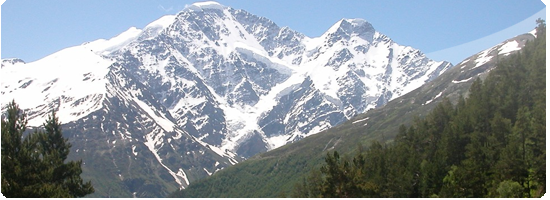
Prielbrusye is a centre of mountaineering, skiing, of summer and winter tourism.
Prielbrusye (Elbrus region) is the tourist name of the part of the Great Caucasus from the western approaches to Mt. Elbrus up to the basin of the river Chegem in the east. Its southern border passes along the Main Caucasian Range. It is a surprising place with majestic summits coated with the ice caps, the picturesque gorges, numerous waterfalls and a mild mountain climate has the status of the National Park. Here in the small territory presented all the landscape and climatic zones typical of Russia and accordingly there are submitted miscellaneous forms of flora and fauna, some species of which -endemics – meet nowhere else on the planet.
Prielbrusye has become one gigantic centre of tourism, mountaineering, skiing and simply holidaymaking. Prielbrusye is a conventional name. The borders of the area have been suggested by nature. At a point beyond thevillage Elbrus the highway enters a forest where tourist centers, mountaineers’ camps and sports schools stands amid the trees – this is where Prielbrusye starts, and it ends, as conventionally with the Azau glade.
The region is rich and varied. Here the tourist paths lead one through gorges, across mountain passes to mountain lakes and unscalable cliffs; they start in the forest, in the damp, cold shade, run crazily along the noisy streams to disappear amidst flowers, now lush in the alpine meadows, now low-growing but immensely bright amidst the snows and screes. Alpine vegetation is very beautiful and varied. Pine and birch woods grow to the 2,700-2,800 meters line, and individual pines are found at a height of 3,000 meters. Higher are alpine meadows.
Prielbrusye becomes better equipped with every year. The sports complex on the slopes of Mount Cheget, a rocky spur between Elbrus and Donguz-Orun, is growing, with cableways, hotels, cafes and shops. The Terskol Tourist Centre is being extended – it along accommodates over 11,000 holidaymakers annually. Terskol was one of the first tourist centers built right in the mountains. Altogether, over 23,000 guests stay every year in the tourist centers of Prielbrusye, while the cableways can carry almost a million people annually. Cableways functions the whole year round. Prielbrusye means not only mountain skiing and holidaymaking, it is also rock-climbing and mountaineering. That is why the number of alpine camps is crowing, with the older ones being altered and extended. The development of the region brought with it a number of new tasks, first of all the question of preserving the place unspoiled. Prielbrusye must be preserved with its natural beauty untouched.
Avalanches are a constant threat in the mountains. A special avalanche service was set up to investigate and forecast avalanches. In designing mountain sport complexes prime consideration is given to the danger of avalanches. The suitability of the region for building and the accessibility of skiing tracks.
In some valleys of Prielbrusye there are more 300 solar days in a year. A large transparency of an air and significant amount of the hours of solar radiance create fine weather conditions in summer and winter. An average humidity makes 67-70 % and in a day time is reduced up to 47 %. An average amount of precipitation is 620 mm per year and in some years it can grow up to 945 mm. The snow cover is fixed in November, in the valley it lie approximately up to the middle of April, in the alpine zone – till May – June. In a whole the Elbrus region is excreted with rather high daytime temperature of an air though the average daily fluctuations can make 19 – 22 degree. The windy mode varies very much from an altitude and the location of the place – from a usual calm at the bottom of a valley up to the frequent hurricanes above than 4000 m. The tourists making an ascent on Mt. Elbrus even in summer should be ready for an arctic chill and a high wind.


 +7 928 691 44 05
+7 928 691 44 05 
 Russia, KBR, city Nalchik
Russia, KBR, city Nalchik



